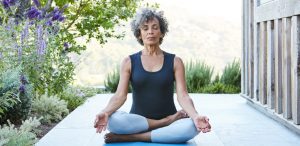No time to read this? Click here to receive this post as a PDF
Science has finally caught up to give a definitive answer whether your practice is the secret to a long, healthy, and youthful life.
Anti-aging hacks are hardly new. Legend has it, Cleopatra used to bathe in donkey milk to extend her youthful glow. Now that we’re living longer—average life expectancy has risen from age 50 to 75 over the last century—the drive to extend our stay here on earth is much higher. As a culture, we spend billions trying to beat the clock, from consuming antioxidants to optimize health to maintaining expensive skincare rituals to doing crazy cleanses, and much more. Among the physical activities, we do to stay young is yoga, and now science supports that your practice may really be the fountain of youth.
At the pop-up conference, Yoga & Science: The Emerging Science of Consciousness Regeneration, Health, and Longevity, in Brooklyn this spring, the top names in the yoga and meditation research communities united to talk about this very topic. They shared how yoga and meditation not only help keep us flexible, but also improve memory, neuroplasticity, immunity, epigenetics, and lifespan.
“Humans have an enormous capacity for self-regulation,” says Sat Bir Khalsa, PhD, assistant professor of medicine at Harvard Medical School at Brigham and Women’s Hospital, and Research Director for Kripalu in Massachusetts. “You can influence gene activity through lifestyle modifications. We’ve even seen healthful practices down-regulate cancer cell growth. This is profound. At a cellular and molecular level, yoga, meditation, and breath work can ignite significant change,” Khalsa says.
A 2015 study published in Frontiers in Human Neuroscience confirmed this notion, proving that yoga can impact brain activity, plasticity and stress reduction. The way it works is that yoga lights up the parasympathetic nervous system while reducing the response of the sympathetic nervous system, best known for “fight or flight” mode. In other words, when we practice, we lower our cortisol, or stress hormone, levels and, as a result, “lifestyle diseases and other chronic conditions can be modified if you develop such tools of self-regulation,” Khalsa says.
Another study—the first of its kind—published in Oxidative Medicine and Cellular Longevity this year further shows the impact yoga and meditation have on cellular aging. “Making yoga and meditation an integral part of our lifestyle may hold the key to delay aging, or aging gracefully, prevent onset of multifactorial complex lifestyle diseases, promote mental, physical, and reproductive health, and prolong youthful healthy life,” wrote lead researchers from the All India Institute of Medical Sciences.
Research published in the Journal of Alzheimer’s Disease in 2016 also found that yoga was more effective at promoting brain activity, specifically memory function, compared to puzzles or other mind-stimulating exercises. Study participants who practiced yoga also saw a decline in anxiety and stress, two common factors that tend to speed up the aging process.
While this body of scientific research is still in its infancy, the results, so far, reveal that when it comes to the health benefits of yoga and meditation, the perks are plentiful and undeniable. What’s more is that it’s never too late to start yoga. Regardless of your age and fitness level, it’s how often you practice that will make the biggest difference, according to data published in Evidence-Based Complementary and Alternative Medicine.
Not ready to get bent on the mat? Try this entry-level practice: Alternate nostril breathing, or nadhi shodhana, with the help our holistic health expert and creator of the Just Sit Series, Lisa Hedley. This powerful practice will help calm the mind, soothe the nervous system, and maybe add a few minutes, hours, days, weeks, months or years to your life, depending on how often you do it.




